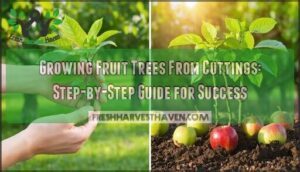This site is supported by our readers. We may earn a commission, at no cost to you, if you purchase through links.

Different fruit varieties have varying success rates—figs and pomegranates root easily while apples prove more challenging. The key lies in matching your cutting type to the season and creating ideal rooting conditions. Master these fundamentals and you’ll discover techniques that can turn any exceptional fruit tree into your personal orchard.
Table Of Contents
- Key Takeaways
- Choosing The Best Cuttings for Propagation
- Preparing Fruit Tree Cuttings
- Rooting Methods for Fruit Tree Cuttings
- Caring for Rooted Cuttings
- Transplanting and Growing New Fruit Trees
- Frequently Asked Questions (FAQs)
- Can you cut a branch off a fruit tree and plant it?
- What fruits can be propagated from cuttings?
- How long does it take for fruit tree cuttings to root?
- What is the easiest tree to grow from cuttings?
- How to grow fruit trees from cuttings?
- Can apple trees grow from cuttings?
- How can I propagate a fruit tree?
- How to grow a fruit tree?
- What fruit trees grow from cuttings?
- Why do fruit trees cut?
- Conclusion
Key Takeaways
- Time your cuts right – Take softwood cuttings in spring when growth is flexible, semi-hardwood in autumn as stems harden, and hardwood during winter dormancy for best success rates.
- Choose easy-rooting varieties first – You’ll have 80-90% success with figs, grapes, and elderberries, while apples and cherries rarely exceed 10% without grafting.
- Create ideal rooting conditions – Maintain 60-65°F temperatures with 70-80% humidity, use rooting hormone immediately after cutting, and plant in a well-draining perlite-sand mix.
- Focus on healthy parent trees – Select disease-free, vigorous trees as your source since you’re essentially cloning their genetics – healthy genes create generations of abundant harvests.
Choosing The Best Cuttings for Propagation
Success starts with selecting the right cuttings from healthy parent trees at the proper time of year. You’ll need to match your cutting type to the season and choose fruit varieties that root well from cuttings rather than requiring grafting.
Selecting Healthy Mother Plants
When selecting mother plants for fruit tree cuttings, you’re choosing the genetic foundation of your future orchard. Focus on disease resistance and vigor assessment by examining trees that consistently produce quality fruit without frequent treatments.
Choose your parent trees like you’re choosing the DNA of your future orchard—healthy genes create generations of abundant harvests.
Consider the genetic history and age considerations of potential parent trees, as younger, healthier specimens typically yield better scion wood for hardwood cuttings, softwood cuttings, and semihardwood cuttings with superior rooting success rates.
Timing for Softwood, Semi-Hardwood, and Hardwood Cuttings
Timing determines success rates when taking fruit tree cuttings. Take softwood cuttings in spring and early summer when new growth is green and flexible. Semi-hardwood cuttings work best in autumn as stems begin hardening. Collect hardwood cuttings during the dormant season when trees aren’t actively growing, typically late fall through winter.
Identifying Suitable Fruit Tree Varieties
When choosing fruit tree varieties for cuttings, focus on species with proven success rates. Figs, grapes, and elderberries achieve 80-90% rooting success with basic care, while stone fruits like apples and cherries rarely exceed 10% without grafting.
Consider your climate’s cold hardiness requirements and disease resistance when selecting parent trees for fruit propagation projects. For colder regions, consider using Malus baccata rootstock for apple trees.
Preparing Fruit Tree Cuttings
Proper preparation turns raw cuttings into healthy new trees through careful handling and treatment. You’ll need clean tools, proper cutting techniques, and rooting hormones to maximize your success rate.
Essential Tools and Sterilization Methods
Proper tool sanitation forms the foundation of successful fruit tree propagation and disease prevention. Clean cutting instruments prevent pathogen transmission that can devastate your hardwood cuttings and softwood cuttings before they establish roots.
Essential propagation supplies include:
- Sharp pruning shears or grafting knife for precise cuts
- Isopropyl alcohol (70% concentration) for alcohol sterilization between cuts
- Clean containers for rooting hormone application and cutting storage
Always sterilize your tools before moving between plants to maintain healthy propagation conditions. Many people buy specialized cutting tools for this purpose.
Cutting Techniques for Different Wood Types
Different wood types demand specific cutting approaches for ideal rooting success. Softwood cuttings should be 4-6 inches long, taken from new spring growth, capturing that tender green stem. Semi-hardwood cuttings require firmer, partially matured wood from late summer. Hardwood cuttings need fully dormant winter wood, cut longer at 8-12 inches to account for slower rooting during their extended propagation period.
Correct timing is essential, as is understanding seasonal pruning practices to promote healthy growth.
Using Natural and Commercial Rooting Hormones
After cutting your cuttings, you’ll need rooting hormone to boost success rates. Commercial synthetic auxins deliver consistent results, with hormone concentration being critical—too little reduces rooting success, while too much kills cuttings. Natural alternatives like willow water work well for easy-to-root species but underperform on challenging fruit trees. Currants can also be used as a natural rooting hormone. Apply root growth hormone immediately after cutting for maximum effectiveness.
Rooting Methods for Fruit Tree Cuttings
Once you’ve prepared your cuttings, it’s time to give them the perfect environment to develop strong roots. You’ll choose from three proven methods—direct planting, air layering, or water propagation—each designed to match your cutting type and maximize success rates.
Step-by-Step Softwood and Hardwood Propagation
Start with fresh softwood cuttings from healthy, disease-free branches during peak growing season. Apply rooting hormone to cut ends, then plant in a well-draining medium like a perlite-sand mix. Maintain 60-65°F with indirect light and proper ventilation.
Hardwood cuttings require longer rooting periods but follow similar hormone application and environmental control principles for successful propagation.
Air Layering Techniques Explained
Air layering offers propagating fruit trees an alternative when cuttings struggle to root. Using bark ringing, you’ll remove a complete ring around healthy branches, then apply rooting hormone. Wire wrapping provides another option—tightly wrap wire to restrict nutrient flow.
Moisture control becomes critical as you wrap the wounded area with damp sphagnum moss and plastic.
Timing considerations matter most during active growth periods when branch selection focuses on vigorous, disease-free wood.
Choosing The Right Rooting Medium and Conditions
Three rooting mediums work best for cuttings: perlite mixed with sand prevents rot, while soilless mixes promote drainage solutions. You’ll need bottom heat application maintaining 65-70°F temperature range, plus humidity control at 80-90%. Provide indirect lighting needs, sterilize your medium, and apply rooting hormone before planting. See options for purchasing perlite mixes online. **These conditions create the perfect environment for root growth hormone activation.
Caring for Rooted Cuttings
Once your cuttings develop a healthy root system, you’ll need to provide the right environment for continued growth. Proper care during this critical phase determines whether your new fruit trees will thrive or struggle as they establish themselves.
Providing Optimal Light, Temperature, and Humidity
Your fruit tree cuttings need specific environmental conditions to thrive. Keep them in bright, indirect light while maintaining temperatures between 60-65°F for ideal rooting. Humidity levels should stay around 70-80% using plastic covers or misting systems.
Make certain proper ventilation to prevent fungal issues, and make seasonal adjustments as outdoor conditions change. Monitor these factors daily for successful softwood cuttings propagation.
Preventing Disease and Root Rot
Disease prevention begins with using sterile tools and proper watering techniques. Clean your cutting tools with 70% isopropyl alcohol between each cut to eliminate 99% of plant pathogens. Maintain excellent air circulation around your fruit tree cuttings to reduce fungal outbreaks by 40%.
Apply copper-based fungicide treatments when needed, and make certain your rooting medium provides proper soil drainage to prevent waterlogged conditions that encourage root rot. Overwatering leads to oxygen-starved soil where fungi can thrive.
Fertilizing and Watering for Healthy Growth
When your fruit tree cuttings develop a strong root system, proper nutrition becomes essential for sustained growth. Balance is key—too much fertilizer can burn tender roots, while too little stunts development.
Here’s your feeding and watering roadmap:
- Test soil pH regularly – Most fruit trees thrive between 6.0-7.0 pH levels
- Use diluted liquid fertilizer – Quarter-strength solutions prevent nutrient burn during establishment
- Watch for deficiency symptoms – Yellowing leaves often indicate nitrogen needs
- Apply balanced fertilizer types – 10-10-10 ratios work well for young cuttings
- Master watering techniques – Keep soil consistently moist but never waterlogged
Monitor your cuttings’ nutrient requirements closely during this critical phase. Rooting hormone effects fade as natural root development takes over, making proper fertilization essential for strong, healthy fruit trees.
Transplanting and Growing New Fruit Trees
Once your cuttings develop strong root systems, you’ll need to carefully transplant them into nutrient-rich soil to establish healthy young trees.
This critical phase requires proper timing, gradual acclimation to outdoor conditions, and ongoing care to guarantee your propagated fruit trees thrive for years to come.
When and How to Transplant Rooted Cuttings
Rooted cuttings need transplant timing when roots reach one to two inches long. Prepare well-draining soil with compost before moving your fruit tree cuttings. Check for rootbound cuttings by gently lifting from containers.
Hardwood cuttings typically develop stronger root systems than softwood varieties.
Post-transplant care includes consistent moisture and protection from harsh conditions during the critical establishment period.
Acclimating Young Trees to Outdoor Conditions
Gradual hardening off prepares your rooted cuttings for outdoor life. Start by placing them outside for two hours daily, gradually increasing exposure over ten days. Protect from wind and temperature fluctuations using shade cloth or cold frames. Monitor for sun scald on tender leaves and watch for early pest activity. This slow adjustment strengthens the root system and prevents shock in your developing fruit trees.
Proper soil preparation is essential for the young trees to thrive.
Long-Term Orchard Management and Care
Your orchard management journey begins with mastering Pest Management through regular scouting and integrated approaches. Maintain Soil Health with annual testing and balanced fertilization. Apply proper Pruning Techniques during dormancy to strengthen structure. Practice Fruit Thinning early for quality improvement. Develop consistent Irrigation Strategies based on tree age and rainfall.
These practices guarantee your fruit tree cuttings mature into productive trees, transforming your hardwood cuttings propagation efforts into thriving scion wood that delivers abundant harvests for years.
Frequently Asked Questions (FAQs)
Can you cut a branch off a fruit tree and plant it?
Want to turn that fruit branch into a new tree? You can, but success isn’t guaranteed. Softwood cuttings from spring growth work best—they’ll root fastest with proper care and rooting hormone.
What fruits can be propagated from cuttings?
You can propagate plums, grapes, figs, pomegranates, and citrus fruits from cuttings with good success rates. Softwood cuttings work best for most varieties, though apples, cherries, and peaches rarely root successfully.
How long does it take for fruit tree cuttings to root?
You’d think rooting would take ages, but softwood cuttings can root in about a month. Semi-hardwood and hardwood cuttings need longer—anywhere from several weeks to months, depending on species and conditions you provide.
What is the easiest tree to grow from cuttings?
Plums are your best bet for easy rooting success. These trees root readily from softwood cuttings with high success rates.
You’ll have better luck than with apples, cherries, or peaches, which rarely root.
How to grow fruit trees from cuttings?
Ready to discover nature’s secrets? Take softwood cuttings from green stems in spring, dip in rooting hormone, plant in well-draining soil, and keep moist in indirect light until roots develop.
Can apple trees grow from cuttings?
Apple trees can root from cuttings, but they’re notoriously difficult. You’ll have better success with softwood cuttings taken in spring, using rooting hormone and proper care techniques.
How can I propagate a fruit tree?
Take softwood cuttings from new spring growth, dip in rooting hormone, plant in well-draining medium like perlite, and maintain 60-65°F with indirect light and high humidity until roots develop.
How to grow a fruit tree?
Start with quality seeds or nursery saplings, plant in well-draining soil with full sun exposure, water regularly but don’t overwater, and provide proper spacing for growth.
What fruit trees grow from cuttings?
You’ll find success growing plums and some crabapple varieties from softwood cuttings, though traditional orchard fruits like apples, cherries, and peaches rarely root this way.
Why do fruit trees cut?
Cutting fruit trees, propagating through cuttings, cloning methods—you’re basically creating genetic copies. You cut branches to bypass seedling variability, preserve desirable traits, and accelerate fruiting by skipping the juvenile phase entirely.
Conclusion
Successfully growing fruit trees from cuttings transforms your propagation potential permanently. You’ve mastered the methods for selecting healthy wood, timing your cuts, and creating ideal rooting conditions. Whether you’re working with easy-rooting figs or challenging apples, these proven techniques will expand your orchard economically.
Remember that patience pays off—some cuttings take months to establish strong roots. Your dedication to proper care and environmental control determines success rates substantially.
- https://docs.google.com/forms/d/1GAQr3Kn1cURCVHUA82hAga1Wv8DCH0IuqDLRUrOpN7M/viewform?ts=63f4f653&entry.1515682415=https://www.merriam-webster.com/thesaurus%2Fgrowing
- https://premium.britannica.com/mw-unabridged/?utm_source=mw&utm_medium=inline-def&utm_campaign=evergreen
- https://garden.org/learn/articles/view/25/Grafting-Fruit-Trees/
- https://elizapples.com/2016/03/20/on-their-own-roots/
- https://www.youtube.com/c/HeronsBonsaiUK












